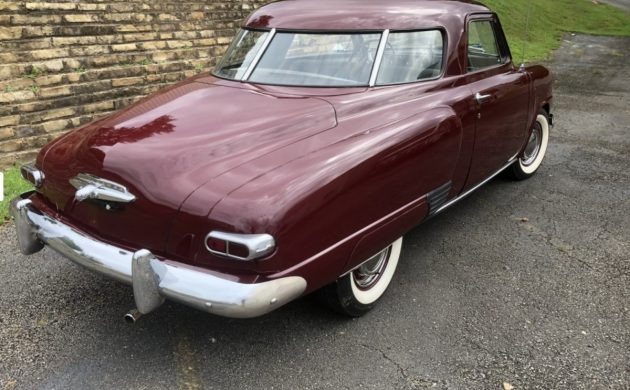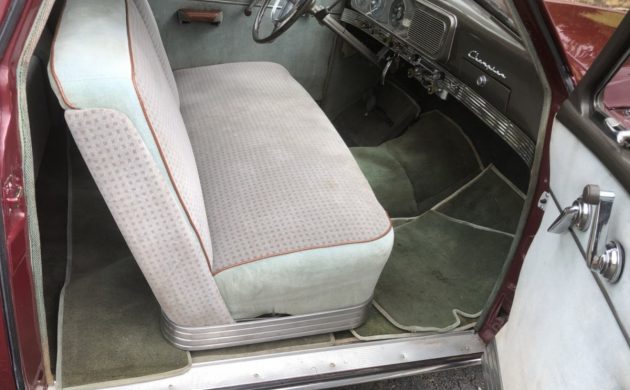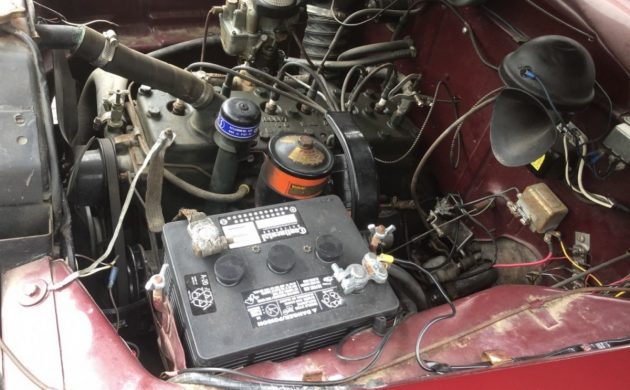1 of 9,829 Champion Starlight Coupes with the Regal Deluxe trim level, this example was restored a while back then eventually placed into storage in an airplane hangar. Recently removed from storage, it’s cleaned up and ready for duty. You can find the listing here on Barn Find Classifieds, with excellent photos and a great write up. It’s located in Greenwood, Arkansas, with an asking price of $11,500.
Introduced in 1947, the styling of this Studebaker was controversial from the start. The unique four-piece wraparound rear window looked like a backward windshield, and people often joked you couldn’t tell it if was coming or going. However, it was certainly a design that stood out in the crowd of boring sedans and is a great option for collectors today who want something different.
This particular Studebaker, as mentioned, has had a previous restoration that appears to have been done well. We don’t know how long ago it was, but the seller claims that the car has been in storage (and probably also driven) for long enough to gain some wear and tear. He describes it as a “two-footer”, meaning you don’t notice much until you are up close. Some of the flaws mentioned are crazing in the paint and cracking in the body filler. There are no pics underneath, but it doesn’t look like there is any rust anywhere, and the seller claims it is a rust-free car. The maroon color on this example is an excellent choice, especially when accentuated by those white-wall tires.
Inside the car is an attractive interior, with a combination of grayish-green fabric, brown trim, and some brightwork. It looks like the doors, seats, and carpet could use a good shampoo, but otherwise no flaws immediately stood out. The seller says they have gone through and fixed everything that needed fixing – almost all the electronics, gauges and accessories work with the exception of the vacuum-controlled wipers. Also, the radio lights up but doesn’t produce any sound.
The engine here is the 169 cubic inch inline-six, paired with a column-mounted 3-speed manual. It would have made around 80 horsepower. Apparently quite a bit of work has been done recently, including rebuilding the carburetor, testing the original 6-volt system, repairing the unique “hill-holder” feature, and completely re-doing braking system. Even after a car has been restored, sitting in storage can be rough on it, but it sounds like everything has been done to get this Studebaker roadworthy again. It is a reasonable price for a unique car that should still provide lots of enjoyment.






Sweet Old Studebaker
It’s so tough to choose between this and the design tweaked 1950 model. I think the wrap around window and horizontal tail lights look perfect but I do like the interior and the ‘bullet nose’ feature of the redesign.
I owned a 1950 Champion Regal Deluxe Starlight Coupe, same color, same basic condition except it was an all original low mileage example. 30 years later, I miss that car. Everywhere I drove it, and that was almost daily in good weather, the public would come running the moment I parked it in a parking lot.
Neat car, but I do prefer the bullet nose of the ’50 and ’51, maybe because I remember my grandfather owning one and it’s one of my earliest automotive memories. I think I’ve read that Studebaker was considering a rear-engine configuration when these were designed?
I drove one for a comedian friend of mine (a lot to unpack there) a 1948 Starlight, restored in this color, for a Studebaker Drivers Club Meet in Nashville TN in the ‘nineties. He and that car originally hailed from Snow Lake, AR. If it’s the same car, the brakes are very stiff but the engine is a strong runner. If it’s the fellow I knew, Hi, hope you’re doing well.
If it’s Jay Leno or Fozzie Bear I think they’re both doing OK these days…
Note to self, store my classic car in a hangar. That car looks awesome.
Very nice looking car.
P.S.
I store mine in a climate controlled storage unit.
I Love this car , but in agreement with the 50 s… nose knows ~!
if i remember right these 6s were prone to burn after a while ken
My father had bought a ’37 Commander straight 8, as I remember it, after WWII. It was just trouble, but only cost $50, maybe a $2000 car by today’s inflation, then bought a ’50 new. Engine was toast at 40,000 miles, burned oil like crazy, but no oil filter, what did he know, uncle’s ’40 Ford, and then ’49 Chevy went more than 100,000 miles, but had oil filters. Rebuilt replacement engine had no dipstick hole – it had not been drilled out of the casting – so engine #3 went in – how the dealership could have missed this was a mystery, and resulted in the end of Studebakers for him. Which was just as well, since, at 16, I really liked the ’56 coupes, but the 4 doors looked very awkward I hoped he would buy something else, which he did, a ’56 Chevy which was a great car for the day.
One of the best looking cars of the early 50’s and I always loved the bullet nosed Starlight coupe. It was one of the only new cars my Mom and Dad ever bought just after they were married in 1949. It was over 40 years later when my Dad bought a new Ford pickup.
https://photos.app.goo.gl/ZgxpM7aVhEUupMim6
Jimmy Olson car!
Clamp-on battery terminal ….
Don’t get caught in a heavy downpour with vacuum-controlled wipers, even if they DO work, unlike this Studebaker’s. Any acceleration brings them to an abrupt halt.
Hi Robert, I am not sure what year AMC started this, but my 65 Rambler runs the vacuum from the fuel pump, so the more you step on the gas, the more vacuum you get. It works great. GP
I’m glad yours works. I was remembering the ’51 Ford and ’54 Mercury my family had. Some probably did work better than others. It certainly makes more sense to have the wipers speed up or stay the same when accelerating than to have them slow down and stop. The only time the wipers on our cars actually stopped was in a heavy downpour. Other times they just slowed down upon acceleration, so we switched them to high speed to keep them operating properly. The Mercury also had performance problems with its four-barrel carburetor. The rear two barrels were vacuum assisted upon passing gear acceleration and refused to operate properly. My dad finally disabled them both and converted the unit into a two-barrel. The engine then operated much better with more power and better gas mileage.
The little relay box and fuse on the fire wall look like one I had long ago that had and overdrive. Very sewing machine smooth.
Good old vacuum wipers, first 2 speed design. Slow and none. Drove one through a monsoon rainstorm from near Buffalo to Carlisle and lucky we made it. Rained so hard water came straight up where the clutch and brake pedals went through the floor. Sold it at Carlisle and bummed a ride home. Good lord the junk we pulled out of barns and fields then drove them 300 miles to sell.